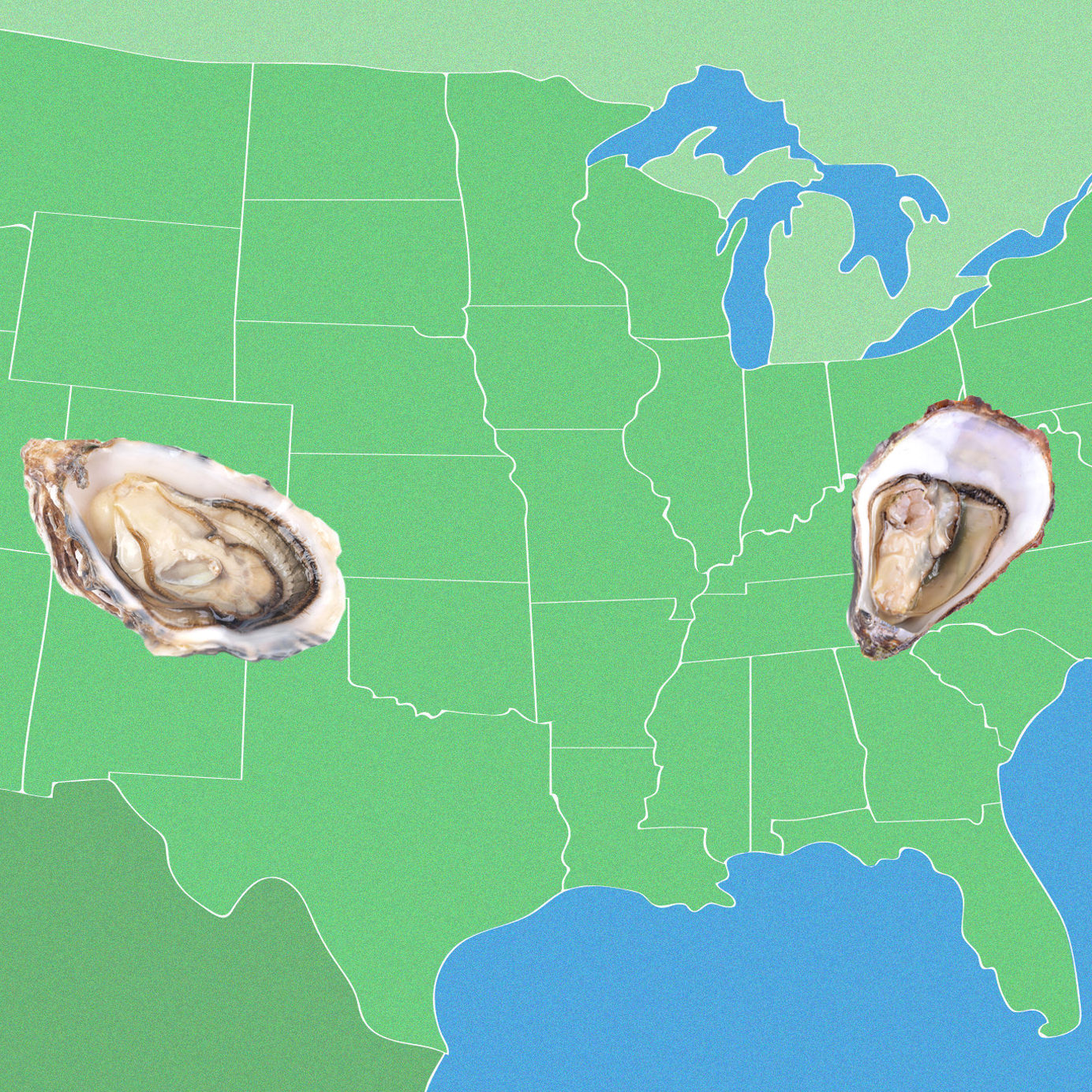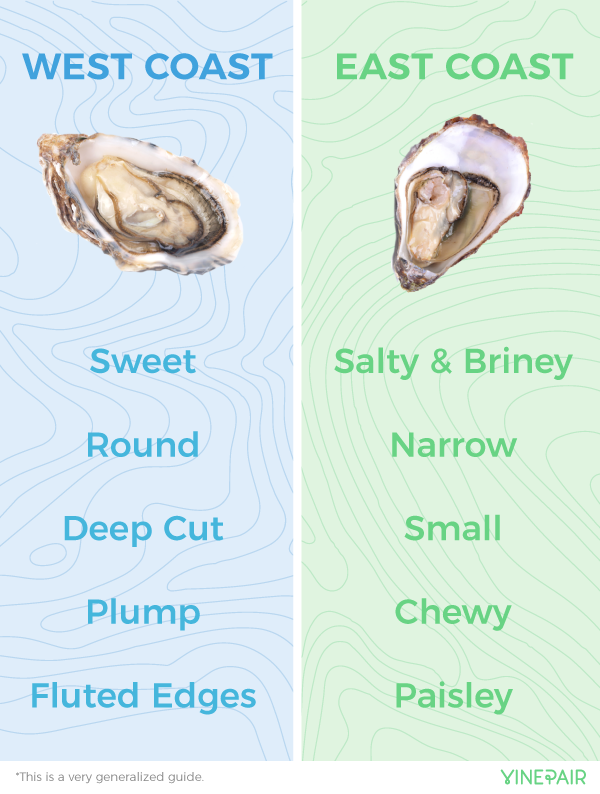Oysters have been a part of the human diet for thousands of years. They are regularly consumed on six of the seven continents. One serving boasts a ton of vitamins and minerals (a whopping 220 percent of your daily zinc) and are one of the few examples of sustainably grown sea life; their vast beds provide habitats for ocean life, they grow naturally in most climates, and a single oyster can filter 50 liters of water every 24 hours.
Oysters even have a rich history in New York City’s booming economy. Hopefully, the days will return when vendors are pushing oyster carts down Mulberry Street, selling Blue Points by the bagful. Until then, we are blessed to have hundreds of raw bars scattered around the boroughs that offer up these delicacies from our great coasts.
Like wine, though, oysters can vary greatly in appearance, taste, and texture depending on where they’re from. Since oysters filter water, they consume all the naturally occurring plankton, bits of plant life, salt and minerals from the water they grow in. The biological makeup of seawater can vary greatly bay to bay, ocean to ocean, and especially north to south. This drastically alters the oysters that live in the various bodies of water.
If this sounds familiar, it’s because it is. The ocean has its own terroir, and it’s known as merroir. It’s how people explain the radical differences between East Coast and West Coast oysters.
East Coast oysters are generally more salty, a bit bigger, chewier, and have a longer, paisley shape. I find them to be a bit more complex because they have a longer growing period and develop very slowly. The warmer the water, the faster they grow and the saltier they are. To put this into perspective, an oyster from Virginia takes a little over a year to reach maturity, while an oyster from Nova Scotia can take up to four years!
Because of the range in temperature of the Atlantic, there are lots of different sized and flavored oysters, each one unique to its locale. Again, you don’t need to know all of them. In fact, when you taste one type from Long Island or Cape Cod, you’ll get a good sense of a typical flavor profile from that area.
The same is true for the West Coast but there tends to be a bit less variation because farmers are more limited to harvesting from Oregon and Washington. West Coast oysters have a signature cucumber or melon note, they’re mild in salt and tend to be smaller overall. Their shells are cultivated to have beautiful fluted edges and are more round with a deep cup. All in all, West Coast oysters are great for the beginner.
Here are a few of my favorites from both delicious coasts with pairings. Remember, until you can taste the nuances – these pairings will work with any oyster from the area!
East Coast
Pemaquid – Damariscotta, Maine
Pairing: Fino Sherry
The Damariscotta River Basin has more oyster bays than I can keep track of and it seems like there’s a new one popping up every day. For me, anything from this area is the quintessential East Coast oyster – small, sweet, and salty. Pemaquids have a perfect balance of all things good with fuller, plump meat.
Beausoleil – New Brunswick, Canada
Pairing: Muscadet
Beausoleils are generally regarded as a great oyster for beginners because of their smooth bite and mild flavor of the sea. They have a uniform white tear drop shell with a signature black crescent. The flavor is refined, very clean, briny and delicate. These were my starter oysters at Walter Food’s in Williamsburg and I will never stop loving and recommending them.
Wellfleet – Wellfleet Bay, Massachusetts
Pairing: Pilsner
There are dozens of oysters that come from Wellfleet Bay and they’re all similar and delicious so don’t be afraid to order from here if you like a salty, briny oyster. These guys are strong-shelled, usually darker in color, with a full cup and, though they have a clean ocean taste, there’s always a touch of sweetness on the finish. WARNING! These guys vary in size so remember to inquire with your server if you have a preference.
Misty Point – Smith Island, Virginia
Pairing: Chablis
Virginia is pretty far south when considering oysters served raw. Any further south and (with a few exceptions) you’re getting into the huge, salt-driven and, sometimes, flabby oysters of the South (great for grilling!) but Misty Points really ride that line beautifully. They’re cultivated to have a deep cup and a plump flesh, still very salty but a fine example of how clean Virginia oysters can be.
Wild Card: Maine Belon
Pairing: Dry Cider
Belons originate from Normandy, France, and Maine is the only place growing them. They are an entirely different species from any other oyster found in the U.S. and have an incredibly distinct metallic flavor. These are for the adventurous, experienced oyster eater! They’re really cool, but be warned of their weirdness.
West Coast
Kumamoto – Washington
Pairing: Junmai Ginjo Sake
Kumamotos are extremely special because they’re actually their own species of oyster. They were brought from Japan and are now almost exclusively grown in Washington. Kumas have a distinct look and taste that you can depend on: They are very small, some only about an inch long, and their shells are dense and round with a nice deep cup. Though they have some clean ocean notes, the dominant flavors in Kumamotos are watermelon and cucumber.
Kusshi – Deep Bay, British Columbia
Pairing: Assyrtiko or a Mediterranean dry white wine
Kusshis are pretty rare on the East Coast. They’re almost a larger version of Kumamoto in appearance and pillowy-soft texture, but have more sought-after savory notes of the Pacific Ocean. They grow to be about two inches and have an incredibly clean flavor.
Baynes Sound – British Columbia
Pairing: Champagne
British Columbia oysters usually have less of the fruity notes than Washington and Oregon oysters, and Baynes Sounds are no exception. They have a bright, salty snap that’s only rounded out by the classic West Coast cucumber note – not dominated by it. These guys are larger than a lot of Pacific oysters, about three and a half inches.
Wild Card: Totten Inlet – Hood Canal, Washington
Pairing: Stout Beer
Yes! If you see these, get a few. They are the only example of East Coast species growing in West Coast waters. Their shells aren’t as deep as the rough and tumble Pacific oysters. They have a clean taste of saline reminiscent of the Atlantic with lots of melon and grass notes. Tottens are a perfect (and hard-to-find) hybrid that’s worth the extra dollar.

